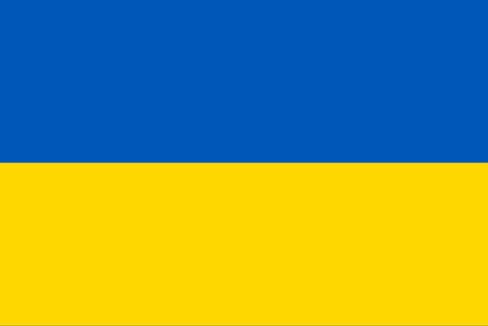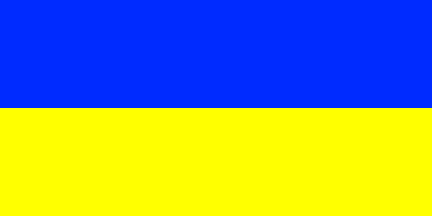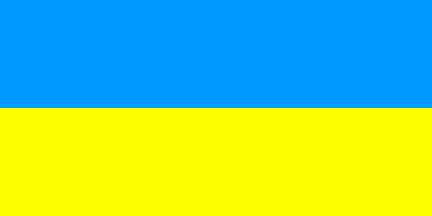 (2:3)
image by Zoltan Horvath, 7 December 2024
(2:3)
image by Zoltan Horvath, 7 December 2024
Last modified: 2024-12-28 by martin karner
Keywords: ukraine | europe | council of europe | central european initiative | oecd | guam |
Links: FOTW homepage |
search |
disclaimer and copyright |
write us |
mirrors
 (2:3)
image by Zoltan Horvath, 7 December 2024
(2:3)
image by Zoltan Horvath, 7 December 2024
Official Name: Ukraine (Ukrayina)
Previous Names: Ukrainian National Republic,
Ukrainian State, Ukrainian Soviet Socialist Republic
Capital: Kyiv
Flag adopted: 28
January 1992
Coat of Arms adopted: 3 September 1996
From www.ukraine.online.com.ua [expired]:
"The Constitution states that the national symbols of
Ukraine shall be the National Flag, the National Emblem and the
National Anthem.
The Ukrainian flag consists of two horizontal stripes of equal
width. The top is blue, the bottom yellow. Blue and yellow, the
colors of the sky, mountains, streams, and golden fields have
symbolized Kyivan Rus' long before the introduction of
Christianity. With the acceptance of Christianity, blue and gold
were incorporated into church symbolism. After the Mongol-Tatar
invasion in the 1200's the use of blue/gold was interrupted, to
be revived again in church ornaments and city crests some time
later. The emblem of the city of Myrhorod, for example, was a
gold trident over a blue background. Another city, Pryluky, used
the head of an ox in gold over a blue background as its insignia.
And in Lubny, the city emblem pictured a hand holding a golden
mace over a blue background. The banners of the Cossacks (17th
century) were blue with gold stars, a gold cross, or with
pictures of saints rendered in gold.
The blue and yellow flag as the national flag of Ukraine by the
Supreme Rada in 1992."
Dov Gutterman, 10 July 2000
The blue-yellow flag was firstly displayed in Lviv (Lvov,
Lemberg) in 1848. Orenburg, for example, has a blue-yellow CoA
too, but it is not in Ukraine. Banners of Cossacks were
different: blue, red, dark-red, green and other.
Victor Lomantsov, 10 July 2000
In Sweden there is a story going around, stating that the blue
and yellow of Ukraine come from the blue and yellow of Sweden.
When King Carl XII of Sweden (he was king 1697–1718) went to war
against Peter the Great of Russia, he made allies with the
Ukrainians, who wanted sovereignty from Russia. The Ukrainians
should therefore have taken up the colours of Sweden as their
colours. However, I don't know if there is any truth in this
story.
Elias Granqvist, 10 July 2000
Ukrainian state flag was adopted on January 28, 1992 by Decree
No 2067-XII of the Verkhovna Rada (=Supreme Council =
Parliament). Other dates (January 21, 1992; September 3, 1996)
are incorrect. Now the Ministry of Justice prepared new project
of law about the State symbols of Ukraine. But it isn't still
adopted.
Resolution of September 4, 1991 gave only possibility to use
Ukrainian National (blue and yellow) flag during the official
ceremonies – before the adopting of new State flag. Please note,
in former USSR we had the term "State flag". So, in
that case "National flag" was not a "State".
But final Decree, named "About the State flag of
Ukraine" was adopted on January 28, 1992. Number of Decree
is 2067-XII. Official publication in "Vidomosti Verkhovnoyi
Rady Ukrayiny" (Official bulletin of the Supreme Council of
Ukraine) was in No. 19 (1992), article 257.
4 September 1991 is the date when blue and yellow flag was first
flew at the building of the Supreme Council in Kyiv (together
with flag of the former Ukrainian SSR). But Decree of the
Presidium of Supreme Council about using of blue and yellow flag
was adopted on September 18, 1991 (No 1567-XII). Literally in
text: "Allow to use blue and yellow flag in all official
ceremonies until the adopting of Constitution of Ukraine."
This Decree doesn't include ratio or other details of the flag.
De-facto, it abolished the former State flag of the Ukrainian SSR,
and proclaimed a blue and yellow as temporary official flag.
Decree of January 28, 1992 proclaimed a blue and yellow as the
State flag of Ukraine.
Andriy Grechylo, 24 March 2004
Official text say: BLUE (sinij [Rus.], syni [Ukr.]).
Unofficially, especially in 1980s, the colour was light-blue
(goluboj
[Rus], blakitnyj [Ukr]).
Victor Lomantsov, 19 December 2002
According to Album 2000 [pay00]
– National Flag and Naval Jack (CSW/CS- 2:3) – Light blue over
yellow bicolour.
Željko Heimer, 10 May 2003
Darker or lighter colours of Ukrainian flag haven't any
political significance. According the legislations we have SYNIY
(blue) and ZHOVTYI (yellow) colours, but our society also accept
darker (e.g. marine blue) or lighter (light blue)
colours.
Andriy Grechylo, 28 November 2004
In his role as the current President of the Council of
Ministers of the European Union, British Prime Minister Tony
Blair has been touring eastern European capitals to try to
resolve the problems with the EU budget. A report on 'The
World' last night on BBC4 showed him speaking at a meeting in a
location which wasn't specified, but, from the panel on the wall
behind him, was clearly connected with Ukraine if not actually in
that country. I was struck by the colours of the Ukrainian flag
next to the EU flag in this photo.
There may indeed be no political significance to the colours, at
least in an internal Ukrainian party sense, but I can't help
feeling that their similarity to the dark blue and gold of the
EU flag isn't a coincidence!
Andre Coutanche, 2 December 2005
The protocol manual for the London 2012 Olympics (Flags and Anthems Manual
London 2012) provides recommendations for
national flag designs. Each NOC was sent an image of the flag,
including the PMS shades, for their approval by LOCOG. Once this was
obtained, LOCOG produced a 60 x 90 cm version of the flag for further
approval. So, while these specs may not be the official government
version of each flag, they are certainly what the NOC believed the
flag to be.
For Ukraine: PMS 2935 blue and process yellow. The vertical flag is simply
the horizontal version turned 90 degrees anti-clockwise.
Ian Sumner, 11 October 2012
The colors listed are the official colors according to the state specification
"DSTU 4512:2006" that was published by the State Committee for Technical
Regulation and Consumer Policy in 2006 (legislation text, in Ukrainian).
Zachary Harden, 6 March 2022
The colors were modified to match the specification
"DSTU 4512:2006" (as mentioned above, 6 March 2022). Under Article 11 of
the Law of the National Flag of Ukraine, this committee is authorized
to publish and enforce technical standards of the national flag
(https://ips.ligazakon.net...).
The Pantone colors are 2935 C blue and 012 C yellow. For the source document see link in message above
(6 March 2022).
Zachary Harden, 6 September 2023 (by e-mail)
The Flag Law defines the flag, but
doesn't give any color specification – but:
☞ On behalf of the State Committee for Consumer Standards of
Ukraine, the Research Institute of Design of NAU and the Ukrainian Research Institute of Textile
Industry determine the color values of the flag:
See https://uk.wikisource.org/wiki/ДСТУ_4512:2006
(in Ukrainian, English translation by Google: [PDF])
> They give the Pantone color values 2935 C for blue and 012 C for yellow.
☞ The flag on top of this page is coloured with Pantone 2935 C for
blue and 012 C for yellow.
Other sources for colors:
Zoltan Horvath, 7 December 2024
 (1:2)
image by BlinxCat, 25 February 2022
(1:2)
image by BlinxCat, 25 February 2022
Longer variants of the flag exist too which resemble that of the 8 September
1991 to 28 January 1992 era flag in the post-Soviet era.
BlinxCat, 25 February 2022
The Open Media Research Institute reported that on 3 September 1996 the Ukrainian Parliament (Verkhovna Rada) had approved the country's national symbols as specified by the constitution [OMRI, #171, 1996]. Parliament also decided to organise a competition on the design of the state arms and the words of the national anthem. The 'tryzub' (trident) is the state arms, and the competition will decide the details of the design. The new constitution was adopted by Parliament 28 June 1996 (the date was declared a national holiday) and only confirmed the national symbols that were already in use [OMRI, #204, 1996]. OMRI offered no details on the action of the parliament, nor did they give any descriptions of the symbols. Article 20 of the constitution states that the 'The description of the state symbols of Ukraine and the order of their use is determined by law' [IFES]:
"ARTICLE 20.
The state symbols of Ukraine are the State Flag of Ukraine, the
State Emblem of Ukraine and the State Anthem of Ukraine. The
State Flag of Ukraine is a banner made from two equal horizontal
blue and yellow fields. The Great State Emblem of Ukraine shall
be determined in accordance with the Small State Emblem of
Ukraine and the Emblem of the Zaporiz'ke Viys'ko (Zaporizhzhya
Cossacks Army) by law, which shall be adopted by no less than
two-thirds of the Constitutional membership of the Verkhovna Rada
of Ukraine. The main element of the Great Emblem of Ukraine is
the Sign of the State of Prince Volodymyr the Great (the Small
State Emblem of Ukraine). The State Anthem of Ukraine is the
national anthem with the music of M.Verbytskiy and words,
confirmed by law, which shall be adopted by no less than
two-thirds of the constitutional membership of the Verkhovna Rada
of Ukraine. The description of the state symbols of Ukraine and
the order of their use is determined by law, adopted by no less
than two-thirds of the constitutional membership of the Verkhovna
Rada of Ukraine. The capital of Ukraine is City of Kyiv."
Dov Gutterman, 1999
 image by António Martins, 17 December 2002
image by António Martins, 17 December 2002
proportions: 1:2
Ukraine declared independence from the USSR on 24 August 1991.
MPs celebrated the event by carrying a huge light blue and yellow
flag through the assembly hall of the Parliament [Ukrainian
Weekly, 1996]. Ukrainians approved the independence proclamation
in a referendum held 1 December 1991. Provisional legislation [W. Smith, 1992]
concerning the flag was adopted on 4 September 1991,
with opposition from the Communists. This legislation therefore
also made the Soviet era flag official, and the two flags were
hoisted side by side (even on the same flag pole). The light blue
over yellow flag was in proportions 1:2. The situation was
changed 21 January 1992, when the light blue and yellow flag
became the only flag of Ukraine. The proportions of the flag were
then set to 2:3. The trident arms were adopted on 19 February
1992 [W. Smith, 1992].
Dov Gutterman, 1999
I saw today in German TV ZDF this variation of Ukrainian
national flag with the national symbol in the left upper corner.
The flag was on a demonstration against the "results"
of the presidential election.
J. Patrick Fischer, 24 November 2004
Today I saw on TV the 1:2-version of this flag. The flag of
yesterday has really 3:5. The yellow of the logo is the same as
the yellow of the stripe.
J. Patrick Fischer, 25 November 2004
This variation of Ukrainian flag was in project of the New
Constitution (1997). But finally the Parliament (Verkhovna Rada)
accepted our proposal – without image in the left upper corner.
So, some people use variations of national flag (with Trident at
shield or with Trident) during holidays, meetings etc.
Andriy Grechylo, 25 November 2004
I have taken a couple of photos of the Ukrainian demonstration in Munich on 7 Feb 2015. [https://groups.yahoo.com/neo/groups/FLAGS/photos/albums/730714280 – link expired]
In addition to the plain bicolour there were several versions of the national flag either with the plain trident or with the trident in a shield:
On this page [picture not retrievable] a variant of the flag of Ukraine is shown with an incorrect version of
coat of arms in canton: the colors are reversed and a white border
added all around.
Tomislav Todorovic, 4 August 2015
Another variant of the national flag containing the national emblem, also
known as the "Tryzub".
Tomislav Todorovic, 4 March 2022
 still image from video located by Peter Hans van den Muijzenberg
still image from video located by Peter Hans van den Muijzenberg
The 5th of May 2023 version of "Break the Fake" (video [retrieved, watch at 0:25]) starts with showing how a
representative of Russia does his utmost to demonstrate that Ukraine
does not exist [Assembly of Black Sea Economic Cooperation, May 4–5, Ankara]. To this end, he grasps the flag the non-existent
representative of Ukraine holds, and runs away with it before anyone can
react. Not having thought through the theft, he finds that he can not
get away quickly enough because he is indoors, and he is quite quickly
overtaking by a non-existent representative, who "angrily takes back the
flag". Apart from the relative speeds of a thief and a non-existent Ukrainian,
the incident is also noticeable for the flag in question having Tryzub
arms on it (still image). Not that in itself this is something impossible, but I don't
know whether/where we have that one, and whether we mention it is used
by representatives of Ukraine.
Peter Hans van den Muijzenberg, 6 May 2023
Indeed we don't have an image with exactly this flag yet (which doesn't mean we don't want it for our ws). One reason is that this kind of national
flags are not official, an other reason: There are lots of variants of the national flag with any sort of
the trident. On this page we have two depictions and several variants reported in written form (see above).
The official national emblems are the bicolour national flag (without device) and the State Arms with the
trident (Tryzub). Having said this, there are of course
numerous official flags, like the Presidential flags and standards and
ministerial and government organizations flags, displaying the trident in various combinations.
There is also an unofficial merger flag at 1:51 in the video
(picture, picture).
It's a merger of the national flag and the Ukrainian Insurgent Army flag (1942–56).
Martin Karner, 6 May 2023
See also: TRIDENT in Dictionary of Vexillology
The flag with yellow above blue is much promoted by nationalist movements as
the "true" flag of Ukraine, with its origins being claimed as early as in the
19the century. It is also meant to be the flag of a "new" Ukraine, which would
terminate the continuity with the "bad past" (the quotation marks used here
because there may be no absolute consensus on what this "new" Ukrainian identity
would actually mean).
Sources:
[1] Time for Action website:
https://timeforaction.in.ua/zhovto-blakytnyj-prapor-symvol-ukrayin/
[2]
Time for Action website:
https://timeforaction.in.ua/zhovto-blakytnyj-prapor-peremogy-prap/
[3]
Change the Flag website:
https://www.prapor.info/
Tomislav Todorovic, 4 March 2022